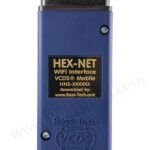Understanding the intricate communication network within your vehicle can empower you to diagnose issues, customize features, and gain a deeper understanding of its inner workings. This exploration delves into the world of CAN bus sniffing, specifically focusing on how to leverage a Vcds Can Bus Sniffer to unlock valuable data hidden within your car’s electronic control units (ECUs).
Deciphering CAN Bus Frames with VCDS
A common question among automotive enthusiasts and DIY mechanics is how to interpret the raw CAN data that VCDS displays. The challenge lies in translating the information presented by VCDS into a usable format for custom applications, such as logging data or developing bespoke control systems.
For instance, if you want to monitor oil temperature, which isn’t always available through standard OBD-II PIDs, understanding the structure of VCDS measuring block frames is crucial. Knowing the CAN ID for the instrument cluster, where this data might reside, is the first step. But how do we determine if the CAN ID displayed in VCDS, such as “Address 47: Sound System (J525),” directly translates to decimal 47 or hexadecimal 2F? Unraveling this mystery requires deeper knowledge of CAN bus protocols and how VCDS interacts with them.
Beyond OBD-II: Unlocking Hidden Data
The power of a VCDS can bus sniffer extends far beyond simply reading standard OBD-II data. It opens up a realm of possibilities for accessing proprietary information and parameters not readily available through conventional diagnostic tools. This capability is particularly appealing for advanced users who want to delve into areas like:
- Custom Data Logging: Recording specific parameters like oil/coolant/transmission temperatures for performance monitoring and analysis.
- System Integration: Developing custom solutions, like warning systems triggered by exceeding predefined temperature thresholds.
- Reverse Engineering: Understanding how specific modules communicate and function within the vehicle’s network.
Consider the example of modifying a vehicle’s suspension system. Disabling the factory magnetic ride control often leads to error messages. By utilizing a VCDS can bus sniffer, you can intercept and decode the communication between the suspension controller and other modules, such as the headlight leveling system. This allows for the creation of custom messages to “spoof” the presence of the original suspension controller, eliminating error codes and enabling seamless integration of aftermarket components.
The Need for Documentation and Tools
The biggest hurdle in CAN bus analysis is the lack of comprehensive documentation for proprietary protocols. Unlike OBD-II, which has standardized PIDs and data formats, manufacturer-specific CAN communication remains largely undocumented. This is where a VCDS can bus sniffer combined with tools from companies like CSS Electronics becomes indispensable. These tools provide the ability to capture and analyze raw CAN traffic, enabling users to decode messages and reverse engineer the underlying communication protocols.
From Captured Data to Actionable Insights
The key to successful CAN bus analysis lies in understanding how to effectively capture, decode, and interpret the data. While a VCDS can bus sniffer provides the raw data, further analysis is often required. This might involve:
- Identifying CAN IDs and Message Structures: Recognizing patterns in the data to determine which IDs correspond to specific modules and how the data within each message is organized.
- Decoding Data Fields: Understanding the meaning and units of each data field within a CAN message. This often involves consulting data sheets or engaging in reverse engineering efforts.
- Analyzing Data Relationships: Observing how different parameters change in relation to each other to gain insights into system behavior.
Conclusion
Harnessing the power of a VCDS can bus sniffer offers a unique window into the complex world of automotive communication. By understanding how to capture and interpret CAN data, you can unlock a wealth of information for diagnostics, customization, and deeper understanding of your vehicle. While challenges remain due to limited documentation, the availability of powerful sniffing tools and a growing community of enthusiasts make this a fascinating and rewarding area of exploration.

